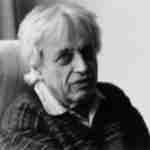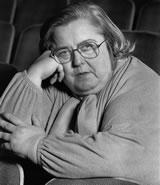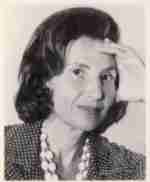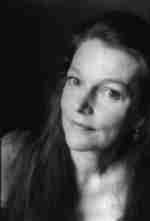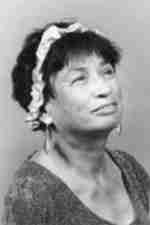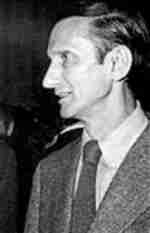|
|
|
GYÖRGY LIGETI, COMPOSER
Austrian-Hungarian composer György Ligeti died in Vienna at the age of 83 on June 12th after suffering a serious illness. We have lost one of the greatest composers of the 20th century. He was an adventurer in form and expression and a great visionary of contemporary music. His richly varied output was uncompromising and individual. He moved far away from aesthetic trends, his music characterized by fresh and unorthodox ideas. Any form of dogmatism was foreign to his nature, his entire oeuvre marked by radical turning points. The sensual accessibility of his music has won the hearts of audiences everywhere. Atmosphères, the orchestral work he created in 1961, made him instantly well-known. In this piece, he worked almost completely without traditional melodic, harmonic and rhythmic parameters and concentrated on sounds with constantly changing textures. Micropolyphony, he once described, "means such a dense tissue that the individual parts become inaudible and only the resulting intermingling harmonies are effective as a form." But techniques were never an end in themselves. Ligeti did not keep long to iridescent tonal surfaces, but always looked for new paths. His father and brother both died in concentration camps; he himself managed to escape the labor service of the Hungarian army in 1941 and fled to Austria after the Hungarian Revolution of 1956. He developed a strong dislike of any dictatorship and any form of intellectual restriction: "I am an enemy of ideologies in the arts. Totalitarian regimes do not like dissonances." Biochemistry, chaos research, fractal geometry - Ligeti, who initially intended to study physics, found inspiration in the natural world for new compositional principles. During his long years as a teacher of international repute, he encouraged the independence, originality and uncompromising self-criticism of his pupils: "There is only one tradition. Our music either stands up to it or not." After his intensive work at the Studio für Elektronische Musik of the WDR in Cologne in the 1950s and the development of micropolyphony in the 1960s, his personal style became simpler and more transparent in the 1970s. And as if wanting to withdraw from the predominating musical tendencies, he began to use tonal sounds again. Ligeti said: 'I no longer listen to rules on what is to be regarded as modern and what as old-fashioned.' His only full-length stage work Le Grand Macabre was inspired by the theatre of the absurd and is teeming with operetta-like wit and black humor. He said, "Stage action and music should be dangerous and bizarre, absolutely exaggerated, absolutely crazy." In the 80s and 90s, Ligeti expanded his musical horizons again, using structural principles of African drumming in his works: the fanatic of the intricate developed new complex polyrhythmic techniques. They form the basis of the 3 collections of his Études pour piano which are considered to be the most important piano music of the end of the 20th century. Ligeti travelled a long road: from Romanian folk music and the tonal language of his fellow countryman Belá Bartók to his own cosmos of sounds. The mentor of a whole generation of composers, he wanted to "fuse the fear of death with laughter." (From the web site of Schott Music, his publisher) György Ligeti: biography and works DONALD MARTINO, COMPOSERfrom the Dantalian Staff: It is with great sadness that we inform you Donald Martino passed away on December 8, 2005, while on a cruise with his wife in the Caribbean. Shortly after 12:30 a.m., off the coast of Antigua, Mr. Martino suffered a heart attack following complications of diabetes. According to his wife, Lora, they were having a wonderful vacation, and his last days were truly happy ones. Having brought his laptop and keyboard with him, Mr. Martino spent each morning - including his last - working on a new CONCERTINO for Violin and Fourteen instruments, commissioned by the Tanglewood Music Center. He will be sorely missed by the music community, and most of all, by his loving family and dear friends. Donald Martino's (1931-2005) musical influences included his jazz clarinet training, Italian bandsman Frank Lieto, twelve-note compositional techniques, and the music of Belá Bartók and Milton Babbitt. He used the twelve-note system "in a more personal manner," (Martino), creating works notable for their expressive intensity. Born in Plainfield, New Jersey, Martino began clarinet, saxophone, and oboe lessons at the age of nine; he played in various bands as a teenager, and started composing at 15. He went on to study composition at Syracuse and Princeton Universities, where his teachers included Ernst Bacon, Milton Babbitt, and Roger Sessions. Between 1954-1956 he also studied with Luigi Dallapiccola on a Fulbright scholarship to Florence, Italy. Martino's academic career continued as a professor at Princeton University in New Jersey, Yale University in New Haven, Connecticut, and as chair of the composition department at the New England Conservatory of Music in Boston, Massachusetts. In the 1980's he taught at Brandeis University in Waltham, Massachusetts, and Harvard University in Cambridge, from which he retired as professor emeritus in 1992. Martino's many honors include the Brandeis University Creative Arts Award, three Guggenheim fellowships, Kennedy Center Friedheim Award, and a Pulitzer Prize for his chamber work Notturno (1973). He was active as a guest lecturer and composer-in-residence at the Atlantic Center for the Arts, Ernest Bloch Music Festival, Festival Internacional de Müsica de Morelia , May in Miami, Pontino Festival, and Tanglewood. Commissions have come from the Coolidge, Fromm, Koussevitzky, and Naumburg Foundations; Boston, Chicago, and San Francisco Symphonies; and the Paderewski Fund. Martino's music is published by his company Dantalian, and has been recorded on the Albany, Boston, Capstone, Centaur, CRI, Koch International, New World, and Ongaku labels. (From the website Art of the States .) SARAH CALDWELL, OPERA IMPRESARIOOpera conductor and director, Sarah Caldwell, died on March 23rd at age 82.
She helped bring creative, unique, worthwhile opera productions into being, while breaking the musical gender barrier. There were many who disagreed with her views on production and musical choice, but she also had a large following of supporters. She brought some highly acclaimed but difficult operas to Boston, including Roger Sessions' Montezuma, Berlioz's Les Troyens, Bellini's I Capuleti et I Montecchi, Schoenberg's Moses und Aron and Prokofiev's War and Peace. Caldwell's early musical development in Missouri and Arkansas led her to study the violin and viola at the New England Conservatory. In 1946 she earned a position at the Tanglewood Music Center where she began staging and conducting operas. Her production of Ralph Vaughan Williams' Riders to the Sea made her a figure of admiration. She soon landed a faculty post at Boston University where she taught opera. Over the years she presented opera productions completely shunning all prior performance traditions related to those works. She was now controversial and she was newsworthy. The November 1975 Time Magazine cover featured her picture over the caption “Music's Wonder Woman.” Sarah Caldwell, became the first female to conduct at the Metropolitan Opera, doing 26 performances of Verdi's La Traviata and five of Donizetti's d'Elisir d'Amore in 1978. At the New York City Opera she directed unusual productions of the modernists, e.g. Richard Strauss' Ariadne auf Naxos and Werner Henze's Der Junge Lord, as well as unique treatments of Verdi's Falstaff and Rossini's Il Barbiere de Seville. Although praised for her productions, she was criticized for her careless sartorial appearance, and in later years not rehired to conduct in a growingly conservative America, obsessed with cosmetically correct looks and the stress on public image. Despite excellent efforts at the Keith Memorial Theater in Boston and later at the University of Arkansas, ill health forced her to leave her duties in 1999, and she finally retired. But she has left a mark on the opera world that will persist in the memory. (by Larry Vide) RUTH SCHONTHAL, COMPOSER
Ruth Schonthal died at age 82. Born in Hamburg, Germany in 1924, she started composing at five and was accepted as the youngest student at the Stern Conservatory in Berlin. In 1938, Hitler's policy of persecutions forced her to interrupt her studies, and the family left for Stockholm. There she was accepted, again as the youngest student and only foreigner, at the Royal Academy of Music. In 1941, yet again because of political insecurity, she and her family had to leave Stockholm. In Mexico, where she stayed for five years, she studied with Manuel M. Ponce. Her early compositions were performed often and to much acclaim. After winning a piano competition, she appeared as soloist in her own Piano Concerto at the Palacio de Bellas Artes. Soon thereafter she met Paul Hindemith, who invited her to study with him at Yale University on a scholarship. She graduated in 1948 summa cum laude. Her extensive and highly diverse oeuvre is performed internationally. In 1994 she received the International Heidelberger Künstlerinnen Preis, was honored with an exhibit of her work and life at the Prince Carl am Kornmarkt Museum in Heidelberg. In the summer of 1999, to celebrate her 75th Birthday, the Akademie der Künste in Berlin arranged concerts, exhibits and lectures of her music and purchased and catalogued her complete archives. That birthday was also celebrated at New York University with a concert of her music performed by members of the music faculty. Her music has been recorded on the Leonarda, Cambria, Capstone, Koch, Albany and Academy labels. (By Joseph Pehrson. See his personal tribute here.) LORRAINE HUNT LIEBERSON, SOPRANO
NEW YORK- Mezzo-soprano Lorraine Hunt Lieberson died on July 3rd at her home in Santa Fe, New Mexico, with her husband, composer Peter Lieberson, at her side. She was 52. The singer had battled breast cancer in recent years and canceled performances in 2005 and 2006 because of back problems. Her death shocked the music world because she often kept details about her health private, said Richard Gaddes, general director of the Santa Fe Opera. "Nonetheless," he said, "she was in a class of her own." "Her voice was so extraordinarily beautiful," he said. "She was just an amazing musician and very serious about her work. She was towering, really." Musical America named her vocalist of the year in 2001. DIKA NEWLIN, PUNK-ROCK SCHOENBERG EXPERT
Dika Newlin, who composed a symphony at 11, became a distinguished composer and musicologist and emerged, in her 70's and 80's, as a most unlikely punk rocker, died on July 22nd in Richmond, Va. She was 82. The cause was complications of a broken arm she suffered on June 30, said Sabine Feisst, a professor of musicology at Arizona State University who is writing a book on Dr. Newlin. "It is hard to find out about me because I'm involved in so many different things," Dr. Newlin said in an interview with The Richmond Times-Dispatch in 1996. One continuing thread: she was a professor at various universities until her retirement from Virginia Commonwealth University two years ago. Her latest incarnation was as leather-clad, bright-orange-haired punk rocker and occasional Elvis impersonator, belting out songs like Love Songs for People Who Hate Each Other, which she wrote herself. Her flamboyant image was not exactly dulled when she posed in her 70's for a pinup calendar. Dr. Newlin's earlier prominence grew out of her studies as a teenager with the composer Arnold Schoenberg. Dr. Newlin, among the last surviving pupils of Schoenberg, wrote the entry on him for the Encyclopaedia Britannica. Dr. Feisst called Dr. Newlin "one of the pioneers of Schoenberg research in America." Dr. Newlin's doctoral dissertation was published as the book Bruckner, Mahler, Schoenberg (1947, 1968). She also translated Schoenberg's works from German to English, and her publication of diaries she kept as his student provide some of the most intimate glimpses of him. Dr. Newlin ' s own compositions reflect Schoenberg 's innovative approach. Those works include three operas, a chamber symphony, a piano concerto and numerous chamber, vocal and mixed-media works. In 1999, she sang in a costumed performance of Schoenberg's Pierrot Lunaire, in her own English translation, in Lubbock, Tex. In her punk incarnation, Dr. Newlin appeared in horror movies produced by Michael D. Moore in Richmond. In Creep (1995), directed by Tim Ritter, her character, clad in a leather motorcycle jacket, poisons baby food on a supermarket shelf. Dr. Feisst confessed to finding this sort of thing "puzzling and disturbing" but said she came to view it as "all part of the package." Mr. Moore also directed "Dika: Murder City" (1995), a documentary about Dr. Newlin. Dika Newlin, an only child, was born in Portland, Ore., on Nov. 22, 1923. Her name, chosen by her mother, refers to an Amazon in one of Sappho's poems. Her parents, both academics, soon moved to East Lansing, Mich., to teach at what is now Michigan State University. Dika could read dictionaries at 3, played the piano at 6 and began composing at 7. She entered grade school at 5 and finished at 8. At 11, she wrote a symphonic piece, Cradle Song. Three years later, it was performed by the Cincinnati Symphony, with Vladimir Bakaleinikoff conducting. She finished high school at 12 and was accepted as a college student by Michigan State, where, The New York Herald Tribune said in 1939, she had the highest I.Q. score in the school's history. At the time of the article, she was in New York to hear one of her compositions performed at the World's Fair. After graduating from Michigan State at 16, she settled with her mother in Los Angeles so that she could attend the University of California at Los Angeles and study with Schoenberg, who taught there. She kept a diary, which she published as a book, "Schoenberg Remembered: Diaries and Recollections (1938-76)," in 1980. Reviewing the book in The New York Times Book Review, Joan Peyser, marveled at its "absolute ingenuousness," saying Dr. Newlin seemed to have censored nothing. In one entry, she tells how Schoenberg, an Austrian émigré she called Uncle Arnold, criticized her string-quartet style as "too pianistic." She replied that she knew it wasn't the best writing. The entry continues, "He replied, 'No, it is not the best, nor even the second best - perhaps the 50th best, yes?'" She earned her doctorate in musicology from Columbia at 22. She studied piano with Artur Schnabel and Rudolf Serkin and made a half-dozen piano recordings in the United States and Europe. Many years later, in 2004, some of her punk numbers were released on an album called "Ageless Icon: The Greatest Hits of Dika Newlin." Dr. Newlin, who never married, leaves no immediate family members. She has a surviving cousin and was close to her cat, Spot. She once kept eight or more cats. Reporters noted that she slept on a mattress on the floor with a medieval suit of armor dangling above. She told The Richmond Times-Dispatch that she had always wanted to have a rock band, and hers surely carried her own brand. Who but Dr. Newlin could have taken the text Schoenberg used for the fourth movement of his second string quartet to use as punk lyrics for Alien Baby? "I feel like a child more than I did as a child," she said in an interview with People magazine in 2003. "I try more and more to live day by day, to do something because it feels good." [By DOUGLAS MARTIN (NYT, July 28, 2006,); The Arts/Cultural Desk - Late Ed. - Final, Section A, Page 27, Col. 3] LEIGHTON KERNER, MUSIC CRITICLeighton Kerner, the longtime music critic of New York's Village Voice, died on April 29th , Opera News reports. He was 79. Kerner also wrote for Opera News, Musical America, and Travel & Leisure. Born in Somerville, Massachusetts, Kerner studied at Tufts University and Boston College. He wrote for Women's Wear Daily before moving to the Voice in 1955, the year it was founded. He wrote for the paper until 2004. Mr. Kerner was a recipient of New Music Connoisseur's award for outstanding new music journalism in 2000 and one of the critics whom we quickly recognized at concerts and chatted with. He could always be observed following the score of the work being played. Leighton was amenable and courteous in manner and did not shrink from conversation with people whom he hardly knew. According to Opera News, Kerner won two ASCAP/Deems Taylor Awards and a letter of distinction from the American Music Center. In his obituary, Opera News editor F. Paul Driscoll wrote, "Although Leighton's critical standards were shaped by long and distinguished service in his chosen field-he was a sharp-eyed witness to all of the most important events in the musical life of New York for a half-century and the range of his knowledge was staggering-he never lost the ability to be excited by a new singer, a new composer, or a new piece of music." (Comments by By Ben Mattison of Playbill and BLC) EDWARD JABLONSKI, AUTHOR
Edward Jablonski, an author with a penchant for musical biography and history, died on from heart failure. He was 81. Jablonski combined these two interests in childhood by hanging out in airports and listening to music. He earned a Silver Star serving in the United States Army Field Artillery during World War II, then graduated from the New School for Social Research. While working for the March of Dimes, Jablonski started writing record reviews and liner notes for albums. This hobby eventually turned into a distinguished, five-decade career in publishing. Jablonski's expertise in aviation and aerial warfare was the focus of several books, including the four-volume series Airwar , and two pictorial histories of World Wars I and II. He wrote "Ladybirds: Women in Aviation," "Flying Fortress: The Illustrated Biographies of the B-17's and the Men Who Flew Them," "Warrior With Wings" and "Seawings.". But he was best known for chronicling the lives of America's greatest songwriters and composers. As a teenager, Jablonski started a correspondence with Ira Gershwin, a letter exchange that turned into a life-long friendship. Jablonski and Lawrence D. Stewart wrote The Gershwin Years in 1958, a biography featuring previously unavailable material from the personal archives of the Gershwin family. Jablonski also penned its 1992 follow-up, Gershwin Remembered . His final book was the 1999 biography Irving Berlin: American Troubadour. (Posted by Marty Jurow on March 3, 2004 on the web) Back in the 1970's I was music director and arranger for a revue based solely on the music of Harold Arlen. Ed Jablonski was the "godfather" of the project. helping attain material for us and seeing to it that Mr. Arlen took part with us in rehearsals. Ed was always a true gentleman and I enjoyed his company immensely. I kept in touch with him throughout the years and enjoyed our phone conversations. I'm shocked to hear of his death last year. I will always remember sharing an ale and talking about music and musicians with Ed. I will miss the great man and great writer. My condolences to his children and family. Mr. Jablonski's books--I've so far read only some of those dedicated to George Gershwin--are a delight. I wish I'd discovered them early enough to have written him a letter of thanks. He brings his subjects to life: swarthy, charming, ego-centric and completely fascinating, George Gershwin is alive to me, and always will be, mainly because of Edward Jablonski's talents. My sincere condolences to his family and friends. E.F. Keck |

